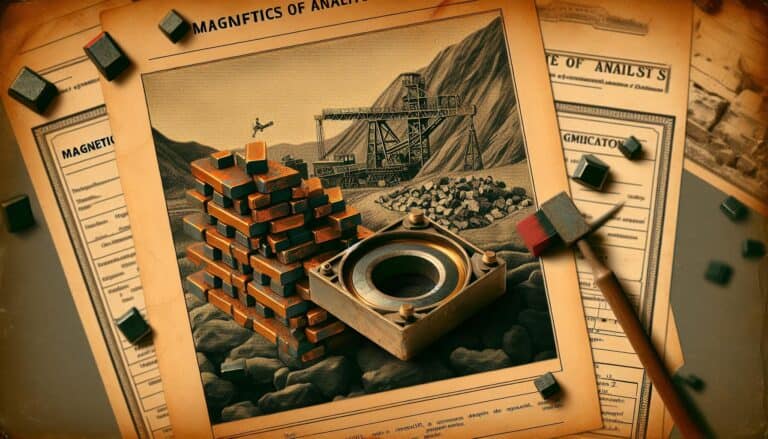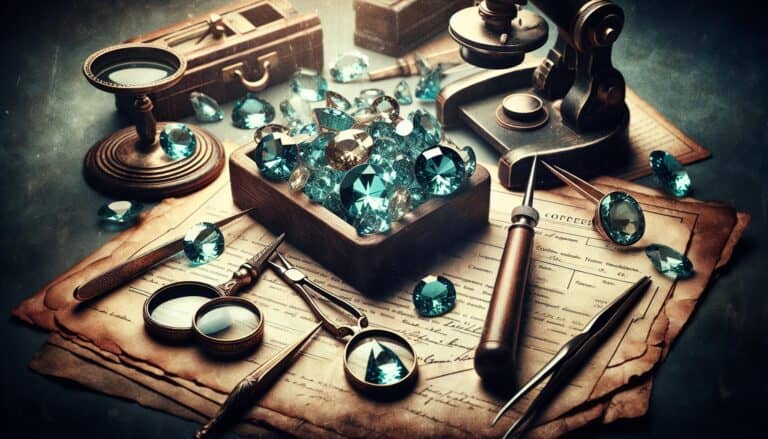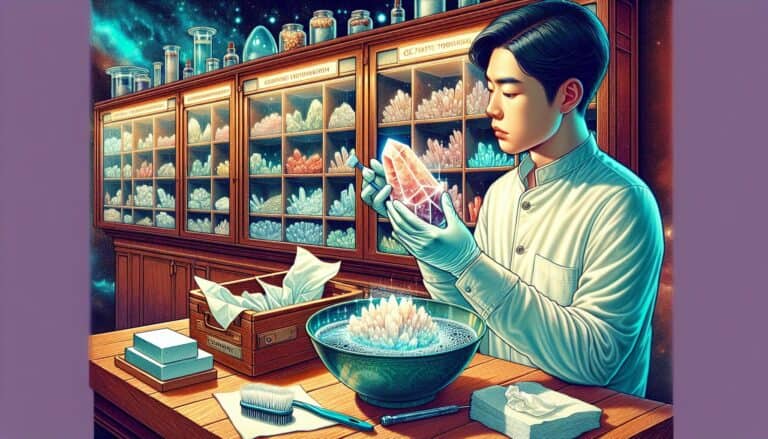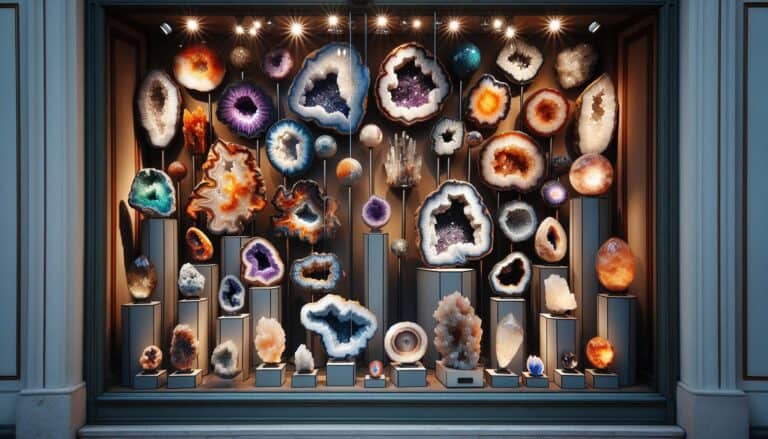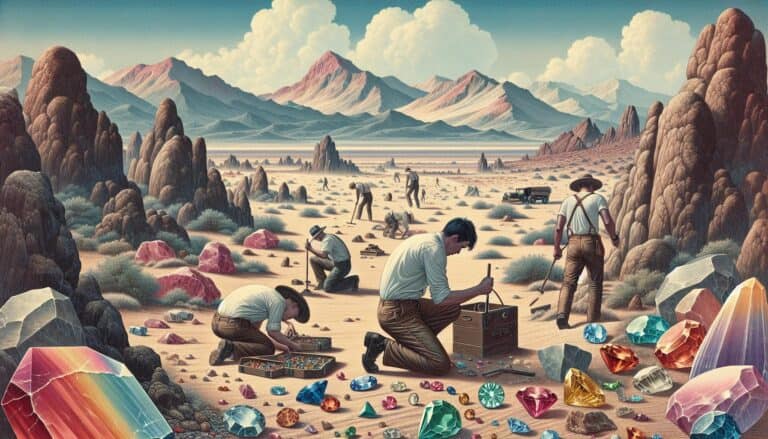Ready to embark on a treasure hunt through Utah’s rugged landscape?
You’re in luck! Utah is a rockhound’s paradise, brimming with geological wonders just waiting to be discovered. From the sparkling topaz in the Thomas Range to the prehistoric trilobites near Delta, the state offers a diverse array of minerals, fossils, and gemstones.
As you gear up for your adventure, knowing the best spots to explore is key. Utah’s vast public lands are dotted with areas rich in geodes, agates, and more. Whether you’re a seasoned collector or a curious newbie, the thrill of unearthing your own piece of natural history is unbeatable.
Let’s dig into the top rockhounding sites in Utah and reveal what treasures lie beneath the surface.
In Utah, rockhounds can explore diverse sites for unique finds. Key locations include Topaz Mountain for topaz, Dugway Geode Beds for geodes, Delta Area for trilobites, Millard County for obsidian, and the Ochoco Mountains for green jasper and Ochoco agates. Remember to respect property rights and check local regulations.
Utah Rockhounding Locations
Immersing yourself in Utah’s rockhounding scene starts with pinpointing the best spots to visit. Topaz Mountain is one such destination that you don’t want to miss. Located in the Thomas Range, this area is renowned for its clear, sherry-colored topaz that can often be found littered on the surface after a good rain. Remember, the sunnier the day, the easier it is to spot these gemstones shimmering in the light.
Heading to Dugway Geode Beds, you’ll be venturing into an ancient volcanic ash bed where hollow geodes filled with quartz crystals await. Ensure you’ve got sturdy tools; cracking these geodes open is like unlocking a geological treasure chest.
The Delta Area is another must-visit locale for rockhounders. You’ll primarily find trilobite fossils here, echoing a time when Utah lay beneath a prehistoric ocean. Be patient and keep your eyes peeled for these subtle remnants of ancient life.
If your interest lies in obsidian, Millard County has the Obsidian Beds known for the naturally occurring volcanic glass. With various colors like black, brown, and red, these pieces are a collector’s delight.
- Topaz Mountain: Sherry-colored topaz
- Dugway Geode Beds: Quartz-filled geodes
- Delta Area: Trilobite fossils
- Millard County: Colored obsidian
Red Beryl is another Utah specialty, sought after by gemstone enthusiasts worldwide. At the Wah Wah Mountains, you might be lucky enough to find this rare mineral that’s even scarcer than diamonds.
Natural, untouched beauty makes Utah a paradise for rockhounders. With regions offering a diverse range of minerals, from the vibrancy of gems to the mystique of ancient fossils, your adventures through these lands will fill your pockets and your spirit with the wondrous gifts of the Earth. Here, every find contributes to the greater mosaic of geological history that Utah proudly showcases.
What Gemstones are Found in Utah?

Utah’s terrain isn’t just a backdrop for adventure; it’s a treasure trove for gemstone enthusiasts. You’ll find a variety of gems, each with its unique allure. The state is dotted with areas rich in gemstones, from topaz to red beryl, and you’re about to discover some of the most sought-after stones.
Topaz and Red Beryl
Your first stop might be the Thomas Range and the Wah Wah Mountains—home to the much-admired Utah state gem, the topaz. These sparkling stones range in color from clear to a deep sherry and can be found, quite literally, just lying on the ground. In the same breath, the Wah Wah Mountains are one of the few places in the world where you can unearth red beryl, a gem so rare that it’s often called “red emerald” for its rich crimson hue.
Variscite and Opal
Variscite, a green gem that can rival turquoise in beauty, is readily found in the Lucin and Fairfield areas. Polished variscite has a waxy luster and can showcase interesting patterns, making for desirable jewelry pieces. Moving on, the Spencer Opal Mine near the Idaho border offers another gemstone experience where you can dig for your own opal. This mine is famous for its precious opals that exhibit vibrant flashes of color.
Utah’s gemstone variety stretches further, with amethyst, garnet, and jasper. Amethyst, a purple quartz, is commonly located in the Wasatch Range. Garnet and jasper are more widespread, but they’re particularly abundant in the San Francisco Mountains and Bear Lake County, respectively.
| Gemstone | Location(s) |
|---|---|
| Topaz | Thomas Range, Wah Wah Mountains |
| Red Beryl | Wah Wah Mountains |
| Variscite | Lucin, Fairfield |
| Opal | Spencer Opal Mine near the Idaho border |
| Amethyst | Wasatch Range |
| Garnet | San Francisco Mountains |
| Jasper | Bear Lake County |
When you decide to go rockhounding, remember to obtain any necessary permits, respect private property rights, and adhere to sustainable collecting practices, preserving Utah’s geological wonders for future generations.
What Sedimentary Rocks You Can Find in Utah?
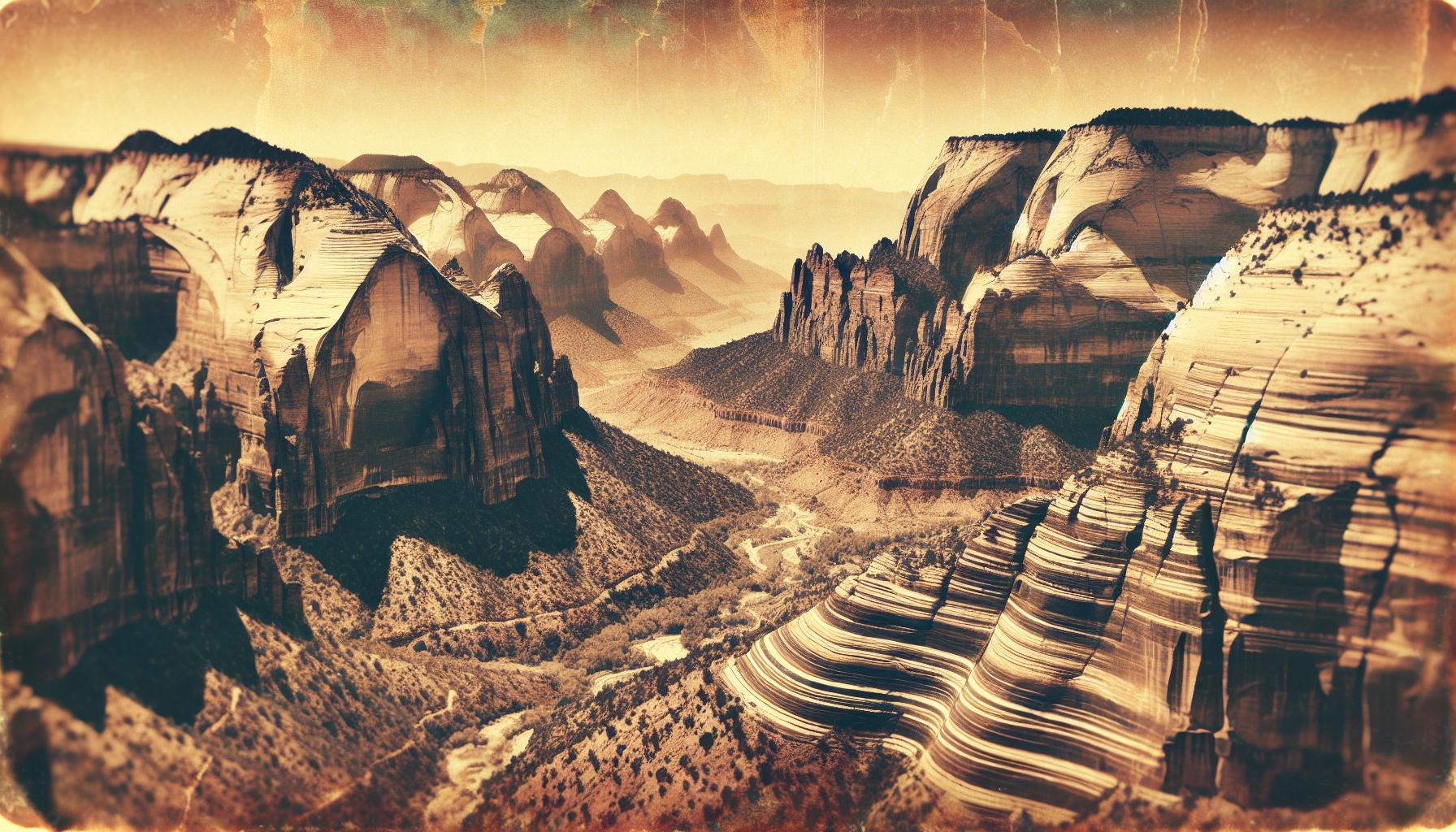
Utah’s geological diversity extends into sedimentary rocks, which adorn the state with layers of geological history. Navajo Sandstone is one of the most prominent sedimentary formations, showcasing sweeping vistas that range in color from reddish to white. Found in the majestic Zion National Park, these sandstone cliffs have been carved by the forces of nature into breathtaking structures.
Limestone accounts for many of Utah’s sedimentary treasures, especially noticeable in the Wasatch Range. This area is also home to fossiliferous limestone, containing imprints of ancient sea life that once thrived in prehistoric seas. Coral Pink Sand Dunes State Park provides a different perspective, with its soft, undulating dunes made up of fine grains of sedimentary rock, slowly weathered from the surrounding sandstone.
Shale, including Green River Formation shale, is prevalent and known for its rarity of fish and plant fossils. You’ll find them in the Uinta Basin, where layers of this fine-grained rock reveal stories of ancient lakes and prehistoric environments.
Here’s a quick glimpse of sedimentary rocks you might come across in Utah:
- Navajo Sandstone
- Limestone
- Shale
These sedimentary marvels offer you a tangible link to the Earth’s distant past. When you’re out rockhounding for these sedimentary specimens, remember to scale the layers of geological time with care and curiosity. Each piece you find isn’t just a rock; it’s a window into an epoch millions of years in the making. Whether you’re a seasoned rockhound or a novice, the sedimentary rocks of Utah offer an enriching experience as diverse as the landscapes they help compose. With each sample, you’ll not only add to your collection but to your understanding of natural history.
What Metamorphic Rocks are found in Utah?
If you’re an enthusiast of metamorphic rocks, Utah won’t disappoint you. The state boasts a variety of metamorphic rocks, formed from the alteration of pre-existing rocks through heat, pressure, and chemically active fluids. These transformed rocks tell a tale of Utah’s dynamic geologic history that spans millions of years.
In the northern part of Utah, especially in the Wasatch Mountains, you’ll find schist, a type of metamorphic rock characterized by its foliated texture. Schist often contains beautiful minerals such as garnet, staurolite, and kyanite, making it not only a geologist’s delight but also a sought-after prize for rockhounds.
Gneiss is another metamorphic rock you may come across in your Utah adventures. Typically found in the High Uintas Wilderness, gneiss displays a distinct banding which is the result of high-grade metamorphism. Here’s a quick glimpse at some of the areas you might want to check out and the metamorphic rocks you can find there:
- Wasatch Mountains: Schist and quartzite
- High Uintas Wilderness: Gneiss and schist
- Oquirrh Mountains: Quartzite
- Big and Little Cottonwood Canyons: Various types of schist
Marble and Quartzite
Digging deeper into Utah’s diverse geology, you might be thrilled to explore areas where marble and quartzite are prevalent. Big Cottonwood Canyon is well-known for its extensive deposits of quartzite, a rock that originally started as sandstone but was transformed under intense heat and pressure. Additionally, Utah houses gorgeous formations of marble, particularly in the vicinity of the Oquirrh Mountains where rockhounds find it in bountiful supply.
Remember, while rockhounding, it’s critical to adhere to the rules and regulations set forth for collection. Various sites may have specific guidelines, and it’s your responsibility to be aware of these before embarking on your rock-collecting journey. Always leave no trace, respect wildlife, and ensure that future generations can enjoy the same natural wonders you’ve experienced.
What Igneous Rocks can You Find in Utah?
Utah’s geological wealth is not confined to metamorphic rocks; the state is also renowned for a variety of igneous rocks. When you’re exploring the diverse terrain, keep an eye out for the visually striking basalt and rhyolite, often found in areas like the Black Rock Desert volcanic field. Here’s what you need to know about the igneous offerings of the Beehive State.
Basalt
Basalt columns in the state are a testament to its volcanic past. These columns formed from the cooling of thick lava flows. Giants like the columns at Devil’s Postpile National Monument may not be in Utah, but the state boasts its impressive basalt formations found in several locations:
- Milford area
- American Fork Canyon
- The extinct volcanoes near Fillmore
Basalt is usually dark-colored and fine-grained, making it fairly easy to spot and identify.
Rhyolite
Another igneous rock you’ll encounter is rhyolite. Characterized by its light color and fine-grained texture, rhyolite results from explosive volcanic eruptions. It’s less common than basalt but can be found in places like:
- Wild Horse Canyon
- Silver Island Mountains near the Bonneville Salt Flats
- Thomas Range known for Topaz and Red Beryl
Obsidian and Pumice
You might also come across obsidian and pumice. These volcanic glasses form an interesting contrast:
- Obsidian, a natural glass, is found in Black Rock, Glass Mountain, and Milford.
- Pumice, which is frothy and light due to trapped gas bubbles, can be found in central Utah’s lava fields.
Remember to carry proper tools and use safety gear when rockhounding for these igneous rocks. The sharp edges of cooled lava can be particularly hazardous. As always, respect the land and its regulations, and ensure you’re collecting only where permitted. Utah’s vast landscapes offer much more than just a rockhound’s paradise—with proper planning and respect for nature, you can unearth some of the Earth’s most intriguing geological treasures.
Panning for Gold in Utah
Venturing into the world of gold panning in Utah, you’ll find no shortage of streams and rivers where the glint of gold could catch your eye. Utah’s history is rich with gold mining, tales of lost mines, and hidden treasures still to be found.
One of the first places you might want to check out is the Uinta Mountains. Here, you can find placer deposits—concentrations of gold that have been released from weathering rock and gathered in streambeds. Historically, rivers such as the Weber and the Provo have been popular spots for gold prospecting.
Don’t overlook the potential of the San Juan River in southeastern Utah, where you can find fine gold particles amidst the river silt. Another hotspot is the Mercur District, which was once a bustling mining town with substantial gold production. Though the mines have long ceased operation, the surrounding rivers carry fine gold particles down from the old mining sites.
When panning for gold in Utah, remember to:
- Obtain the proper permits if required.
- Respect private property and only pan in areas open to the public.
- Use environmentally friendly methods; motorized equipment is often restricted.
It’s vital to stay informed about the local guidelines that govern gold panning and mining activities. Furthermore, consider joining a local prospecting club to gain access to prime locations and to learn the best techniques from seasoned prospectors.
In the Duchesne River, traces of gold can be found hidden within its gravel beds. For those who are persistent, you may just find those shimmering flakes that have tantalized adventurers for centuries. Do bring along a reliable gold pan, a sluice box, and maybe even a metal detector to increase your chances of success.
Rocks and Minerals Found in Utah
Utah is a rockhound’s paradise, brimming with a variety of rocks and minerals that are not only beautiful but also provide a glimpse into the state’s geological history. Topaz is one of the most sought-after gemstones in Utah. You’ll find these shimmering beauties at Topaz Mountain, aptly named for its abundance of the semi-precious gemstone. Here, the Topaz ranges from clear to a deep amber, and on a good day, you might even find some specimens as big and as brilliant as any you’d expect to see in a jewelry store.
Another treasure you might unearth is red beryl, commonly referred to as “red emerald” for its striking resemblance to its greener counterpart. The Wah Wah Mountains are notorious for producing these rare gems. Keep in mind that red beryl is significantly rarer than diamonds, making any find a noteworthy event.
For those interested in fossils, the west desert is scattered with trilobite fossils, remnants of an ancient world when Utah was covered by an ocean. Geodes, known for their hollow cavities lined with crystals, are another common find, particularly in the Dugway Geode Beds. You’re likely to discover geodes that look unassuming on the outside but hide mesmerizing crystals within.
Utah is also home to impressive specimens of copper, found in the Bingham Canyon Mine, one of the largest open-pit mines in the world. Copper isn’t the only metal you’ll find in the state though; silver and gold can be panned in various locations, as previously mentioned.
- Topaz Mountain: Amber topaz
- Wah Wah Mountains: Red beryl
- West Desert: Trilobite fossils
- Dugway Geode Beds: Crystal-filled geodes
- Bingham Canyon Mine: Copper
Bringing the right tools, from shovels and picks to screens and small containers, will enhance your rockhounding experience and increase your chances of uncovering these natural treasures. Always be sure to adhere to the code of ethical rock collecting by respecting the land and obtaining any necessary permits before you begin your search.
Where Can I Find Fossils in Utah?
Utah is a haven for fossil enthusiasts, offering an abundance of sites where you can uncover remnants of ancient life. One of the most renowned fossil-hunting locations is the U-Dig Fossils quarry near Delta, where you’re guaranteed to find trilobite fossils. They’re about 500 million years old! You pay a fee, they provide the tools, and you get to take home what you find.
Another hotspot is Antelope Springs. Known for its abundance of well-preserved trilobite fossils, it’s a site where even beginners can strike it rich. Just make sure to respect the land and stick to the collection rules.
If you’re interested in dinosaur bones, head to the Morrison Formation exposures, which are scattered throughout the state. Areas like Dinosaur National Monument allow you to see fossils still embedded in the rock. However, collecting here is prohibited, but it’s a don’t-miss experience for the visuals alone.
- U-Dig Fossils: Trilobite fossils, pay-to-dig
- Antelope Springs: Abundant trilobites, open to the public
- Morrison Formation: Dinosaur fossils, viewing only
For a unique experience, try the Millard County. This area is home to a range of invertebrate fossils in addition to the more commonly sought-after trilobites. You might spot brachiopods, solitary corals, and even crinoid stems on a lucky day. Remember to collect responsibly, keeping in mind that you’re digging through the pages of Earth’s history.
The Green River Formation is another key location that can reward your efforts with fish and plant fossils. The fine sedimentary layers here make an ideal environment for preserving the delicate structures of these prehistoric creatures.
Keep in mind that some of these sites are on public lands where you can collect for personal use, while others are managed by commercial operators. Always check the latest rules and guidelines before you go to ensure your rockhounding adventure is both successful and legal.
Utah Rockhounding Laws & Regulations
When you’re rockhounding in Utah, familiarizing yourself with state laws and regulations is crucial to ensure that your activities are legal and respectful of the environment. Utah public lands are managed by various agencies, and each may have its own set of rules.
Before you head out, always check with the local Bureau of Land Management (BLM) office or the U.S. Forest Service for the latest guidelines. Generally, rockhounding is allowed on most public lands for personal non-commercial purposes.
Here are some key points you’ll need to keep in mind:
- Limit your collection to a reasonable quantity for personal use. Typically, this means up to 25 pounds plus one piece per day, with a maximum of 250 pounds per year.
- Avoid collecting in National Parks, National Monuments, or State Parks as it is prohibited.
- Use of tools is restricted to small hand tools like picks and shovels; motorized or mechanical equipment is usually not allowed.
- Respect private property; always seek permission before rockhounding on private lands.
Rules for Specific Finds
For petrified wood, there’s a limit of 250 pounds per person per year. However, you should be aware that these limits may change, and special permits may be required for removal in certain areas.
Preservation of Natural Habitats
Utah takes preservation seriously. Disturbing the ground surface and collecting vertebrate fossils like dinosaur bones is not allowed without a scientific permit. Here’s what you can do to stay compliant:
- Refrain from digging in designated wilderness areas, as it’s strictly forbidden.
- Always fill in any holes you dig and leave no trace of your activity.
- Do not use metal detectors where they are prohibited, particularly in sensitive areas that are off-limits to electronic devices.
By adhering to these guidelines, you’ll not only enjoy a fulfilling rockhounding experience but also help preserve Utah’s rich geological history for future generations. Remember to double-check the current regulations with the relevant authorities to stay up-to-date on any changes.
Rockhounding Tips for Beginners in Utah
Embarking on a rockhounding adventure in Utah promises to be an enriching experience as you unearth the hidden gems of the earth. Whether you’re drawn to the hues of agates or the prehistoric allure of fossils, knowing a few insider tips can make your trip both rewarding and trouble-free.
Gearing Up: Essential Tools for Rockhounding
Before you head out to the famed rockhounding sites of Utah, ensure you’ve got the right equipment. Your rockhounding tool kit should include:
- Rock Hammer: A reliable partner for extricating specimens.
- Chisels and Goggles: Essential for splitting rocks while protecting your eyes.
- Gloves: Protect your hands from sharp edges and rough surfaces.
- Sturdy Footwear: A pair of boots can navigate rough terrains and protect your feet.
- Collection Bags or Buckets: For transporting your finds.
- Field Guide and Maps: To identify specimens and navigate sites.
Having these tools will not only aid in sample collection but also enhance your overall experience in Utah’s diverse terrain.
Safety Tips While Rockhounding
Safety should always be at the forefront of your outdoor excursions. Here’s how to stay safe while hunting for geological treasures:
- Stay Hydrated: The Utah climate can be arid; carry enough water.
- Inform Someone: Let a friend or family member know where you’re going.
- Wear Sun Protection: A hat, sunscreen, and long sleeves can shield you from UV rays.
- Be Mindful of Wildlife: Keep an eye out for snakes and other fauna.
- Watch the Weather: Sudden changes can pose risks; always be prepared.
By following these safety measures, you’re set for a hazard-free rockhounding trip.
Legal Guidelines for Rockhounding Enthusiasts
Adhering to legal guidelines ensures rockhounding remains a sustainable hobby for all. Remember these key points:
- BLM and Forest Service: Contact these agencies for the latest updates on collection rules.
- Take Only What You Need: Limit yourself to what’s reasonable for personal use.
- No-go Zones: Steer clear of national parks, monuments, or protected areas.
- Petrified Wood: Special rules apply; be sure to know them before collecting.
- Respect the Land: Leave no trace of your visit, excluding the rocks you legally collect.
Being aware of these legalities helps protect Utah’s natural wonder for future generations of rockhounds.
Conclusion: Utah Rockhounding Map
Embarking on your rockhounding adventure in Utah is an exciting prospect.
Armed with the right tools and knowledge you’re set for a journey into the rugged beauty where treasures lie hidden beneath the surface. Remember to prioritize safety and adhere to the legalities of the land. Doing so ensures that the thrill of discovery is matched by the respect for nature and the law. As you explore the varied landscapes and uncover the geological wonders of Utah, keep in mind that you’re not just a visitor but a steward of these timeless treasures.
Happy rockhounding!


